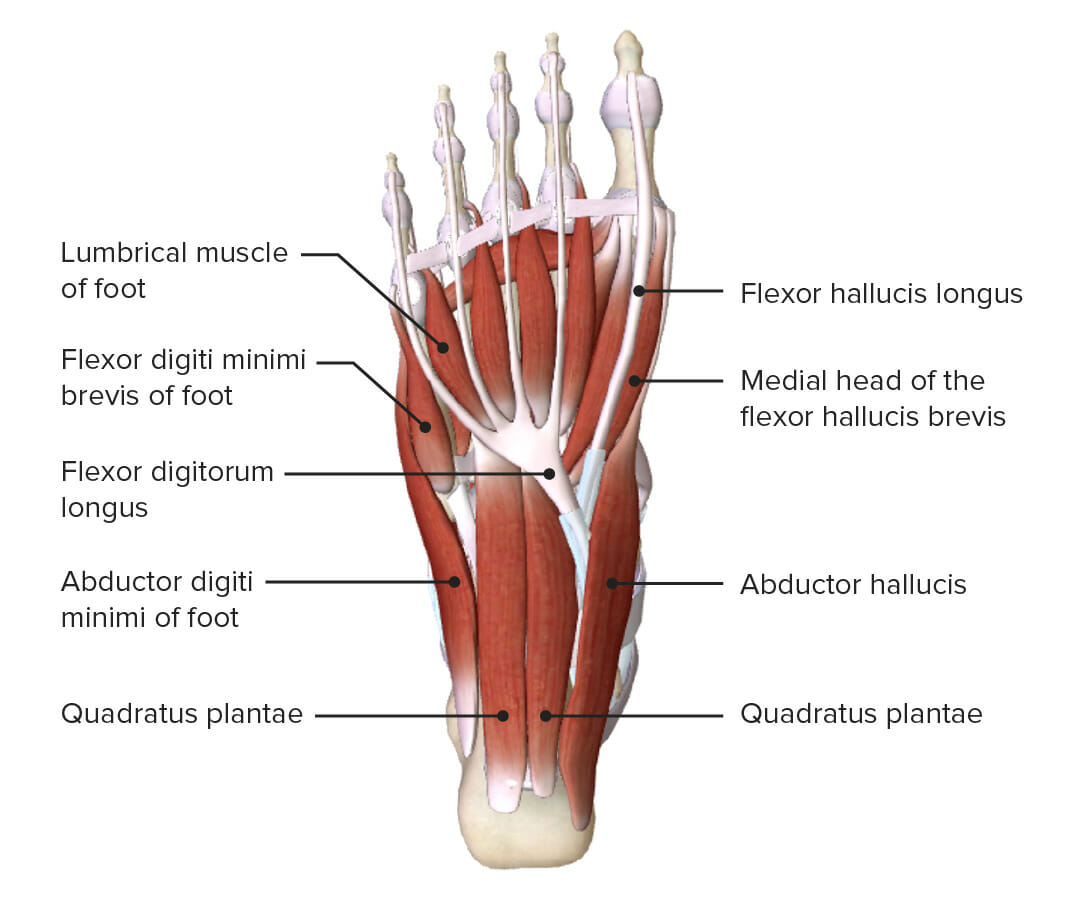Playlist
Show Playlist
Hide Playlist
Plantar Ligaments and Arches of the Foot
-
Slides Plantar Ligaments and Arches Foot.pdf
-
Reference List Anatomy.pdf
-
Download Lecture Overview
00:01 Now let's have a look at some of the ligaments that are associated with the foot. 00:06 We've covered many of these ligaments before when we looked at the specific joints, but now let's look at the plantar ligaments. 00:13 So the plantar ligaments, here we can see, as we look on the sole of the right foot. 00:19 So here we're gonna see the plantar calcaneonavicular ligament, we mentioned that previously as the spring ligament, and that's running from the sustentaculium tali anteriorly to the navicular bone. 00:31 We also have this short plantar ligament, this is the plantar calcaneocuboid ligament. 00:38 That's running from the calcaneus to the cuboid bone. 00:41 And we can see then on top of that, so superficial to that, the long plantar ligament. 00:47 That's running from the calcaneus all the way to the cuboid and the basis of the metatarsals. 00:53 To finish then, we have various arches of the foot. 00:57 And these arches are maintained by the various ligamentous structures we've spoken about holding these bones in position. 01:05 So let's have a look at the arches of the foot. 01:08 So here we're looking at the right foot, and we can see the medial longitudinal arch. 01:14 That really is quite substantial. 01:16 The medial longitudinal arch is formed posteriorly by the calcaneus. 01:21 Then as we move more distally or more anteriorly in the foot, we see we have the head of the talus forming part of the arch. 01:28 We have the navicular the cuneiforms, all three of them forming this medial boundary. 01:33 We have the medial three metatarsals, and these really do help with stability of the foot. 01:40 It's held together this arch by that plantar aponeurosis. 01:44 So tightening of that plant aponeurosis will form this arch to be formed. 01:49 It's also contributed to via this plantar calcaneonavicular, that spring ligament was speaking about. 01:56 And here we've got the talocalcaneal ligaments as well. 01:59 It's reinforced by those anterior fibers of the deltoid ligament. 02:03 And here we can see running down on this medial aspect, tibialis posterior, flexor digitorum longus, and flexor hallucis longus. 02:12 We have a whole series of muscles that then exist alongside these extrinsic tendons that are coming into the foot. 02:20 And without this arch, there wouldn't be any space within the sole of the foot for these to exist. 02:27 Here we can see adductor hallucis. 02:29 We can see flexor digitorum brevis. 02:31 So these muscles and others exist within this medial longitudinal arch that's created by the tension of that plantar aponeurosis, which is forcing the arch to move upwards formed by those bones. 02:46 It's then held in position by these various ligaments associated with the ankle joint and that creates a space for those structures to pass underneath the sustentaculum talus to enter into the sole of the foot. 02:59 A similar arrangement occurs at the lateral aspect, and this lateral longitudinal arch. 03:04 Again, it's formed by the calcaneus, the cuboid now we're on the lateral aspect. 03:09 The fourth and fifth metatarsals, and this also provides stability to the arch. 03:16 The plantar aponeurosis is contributing here to that stability. 03:21 We have the long plantar ligament, this again creates the space for various structures to pass into the sole of the foot. 03:29 So here we have the tendons, the long tendons, the fibularis longus and brevis, coming from extrinsicly into the foot by passing into this space. 03:38 It's also supported here by fibularis tertius. 03:42 So those arches are really important. 03:44 They give you some spring when you're walking and running, but they also create the space for the structures to exist within the sole of the foot. 03:52 Here we have the transverse arch that's formed by the basis of metatarsal one to five. 03:57 Posterior to those we have the cuneiforms. 04:00 And these again, can be stabilized with various ligaments. 04:04 Here we can see some ligaments that are helping to stabilize it, such as the tarsometatarsal, intertarsal, and intermetatarsal ligaments. 04:12 And here we have three tendons coming from extrinsic muscles, tendon of fibularis longus, and the tendons of tibialis anterior, and tibialis posterior. 04:24 So there's lots going on in the joints of the lower limb all the way from the hip joint to the joints around the foot. 04:30 Again, it will be important, especially in the foot region, for you to understand specifically what you need to know. 04:36 Do you need to know all of the ligaments or some of them do because they can be very complex. 04:41 But essentially, those ligaments are named very much after the bony attachments they come from. 04:47 So if in doubt, work out the bony attachments by their name.
About the Lecture
The lecture Plantar Ligaments and Arches of the Foot by James Pickering, PhD is from the course Anatomy of the Foot.
Included Quiz Questions
What forms the posterior part of the medial longitudinal arch?
- Calcaneus
- Head of talus
- Navicular
- Cuneiform
- Medial three metatarsals
What is the function of the plantar aponeurosis within the lateral longitudinal arch?
- Provides stability
- Provides space
- Provides strength
- Physical appearance
- Source of collagen
What is another name for the plantar calcaneonavicular ligament?
- Spring ligament
- Short palmar ligament
- Plantar calcaneocuboid ligament
- Long plantar ligament
- Intermediate plantar ligament
Customer reviews
5,0 of 5 stars
| 5 Stars |
|
5 |
| 4 Stars |
|
0 |
| 3 Stars |
|
0 |
| 2 Stars |
|
0 |
| 1 Star |
|
0 |




